In 2023, the Digital Library of Georgia digitized two unique historical items donated to the Augusta-Richmond County Public Library System. The material was donated by the Augusta Fire Department and includes two oversized, bound ledgers that document thirty years (1906-1937) of fire history in Augusta, Georgia. The ledgers detail several of the most significant and destructive fires in Augusta, making them an important resource for understanding how catastrophic fires shaped the cityscape and its history. Additionally, the Augusta Fire Department (AFD) is the second oldest in the state behind Savannah giving the ledgers an importance in terms of understanding AFD during the early twentieth century, a time when mechanization and new technology were altering the way fires were fought.
Both ledgers document line by line the daily fire alarm box alerts that came into the fire department headquarters on the 1200 block of Board Street, now the Marbury Center. The fire alarm boxes were numbered and spread throughout the city on street corners, telephone poles, and commercial buildings, connected by a telegraph system. When a box was pulled, a pulse was transmitted along a network of low-voltage wiring alerting the fire department. Whether the fire turned out to be small and insubstantial or a major conflagration, it was recorded in the ledger. Along with the time, and the box number, other information was recorded including the date, fire district, street location, building occupant/owner, cause of fire, and the type of building. Financial details such as insurance payouts and the cost incurred by property loss are also noted. Further information concerning damage or what was used to combat the fire may be listed too.
At 6:20 pm on March 22, 1916, as downtown merchants closed up shop for the day and folks were sitting down to evening meals, fire alarm box 34 on the corner of Board and Eighth Streets emitted a shrill call, alerting Augustans to what would become known as, The Great Fire of 1916, the most calamitous blaze in Augusta’s history. Local legend holds that it was started by an unattended iron in Kelly’s Dry-Goods store in the Dyer building on the corner of Eighth and Broad Streets. This has never been proven. Augusta’s fire chief at that time Frank G. Reynolds later called the 30-year old building a “fire trap” because its stairwells were constructed around an elevator shaft, creating an architectural nightmare in terms of fire control.
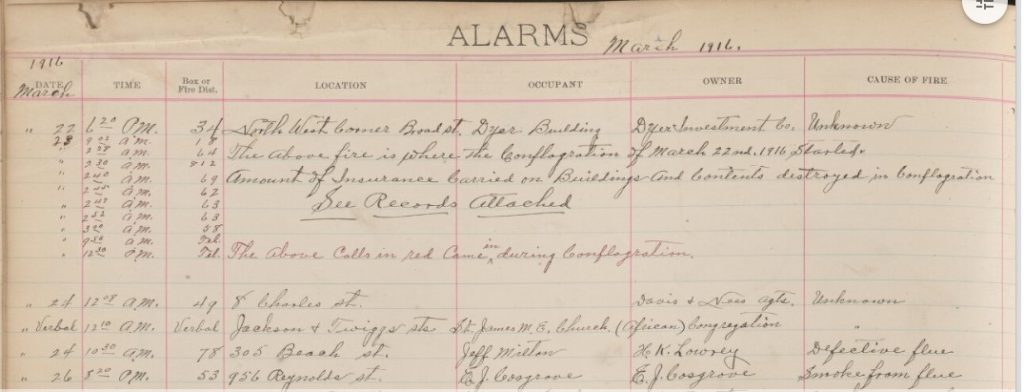
A number of other factors led to the blaze growing in intensity as well. Among them were fierce March winds, which drove the blaze north eastward where it consumed everything in its path, ultimately laying waste to 35 blocks in downtown and Olde Town, burning up 541 dwellings and 141 businesses. 3,000 folks were left homeless. Miraculously, no one was killed. Long-time Augusta Chronicle newspaperman, Bill Kirby noted in his March 20, 2016 column that the winds were so fierce, singed hymnals and prayer books were discovered across the Savannah River in South Carolina.
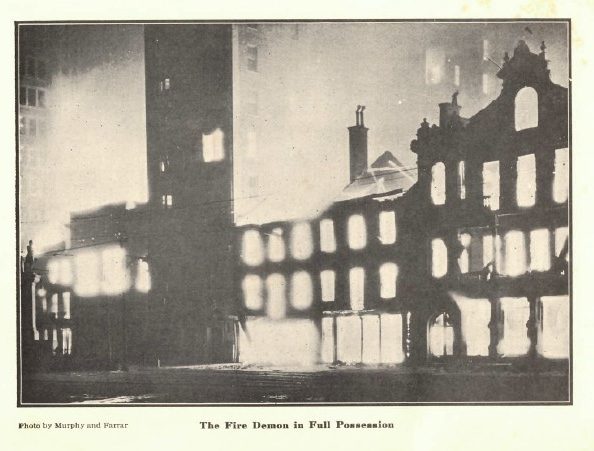
The Great Fire of 1916 is recorded in the 1906-1923 ledger along with notes describing the financial cost of the fire; $4,999,513.00 (nearly $100+ million today) in damages, of which $3,567,763.22 was paid out by insurance, totaling $1,431,749.78 in loss after insurance. Also noted was an issue regarding water pressure, which proved in the days following the fire to be a mitigating factor in the rapid spread of the inferno. Shortly following the fire, Chief Reynolds wrote a scathing indictment printed at length in the Augusta Chronicle, blaming city officials for allowing lax building standards, such as shoddy wood framing and shingles. He also cited inadequate water pressure, which dropped quickly as the fire began and stayed low in the hours that followed. Many of Reynolds complaints were later corroborated by the insurance investigations.
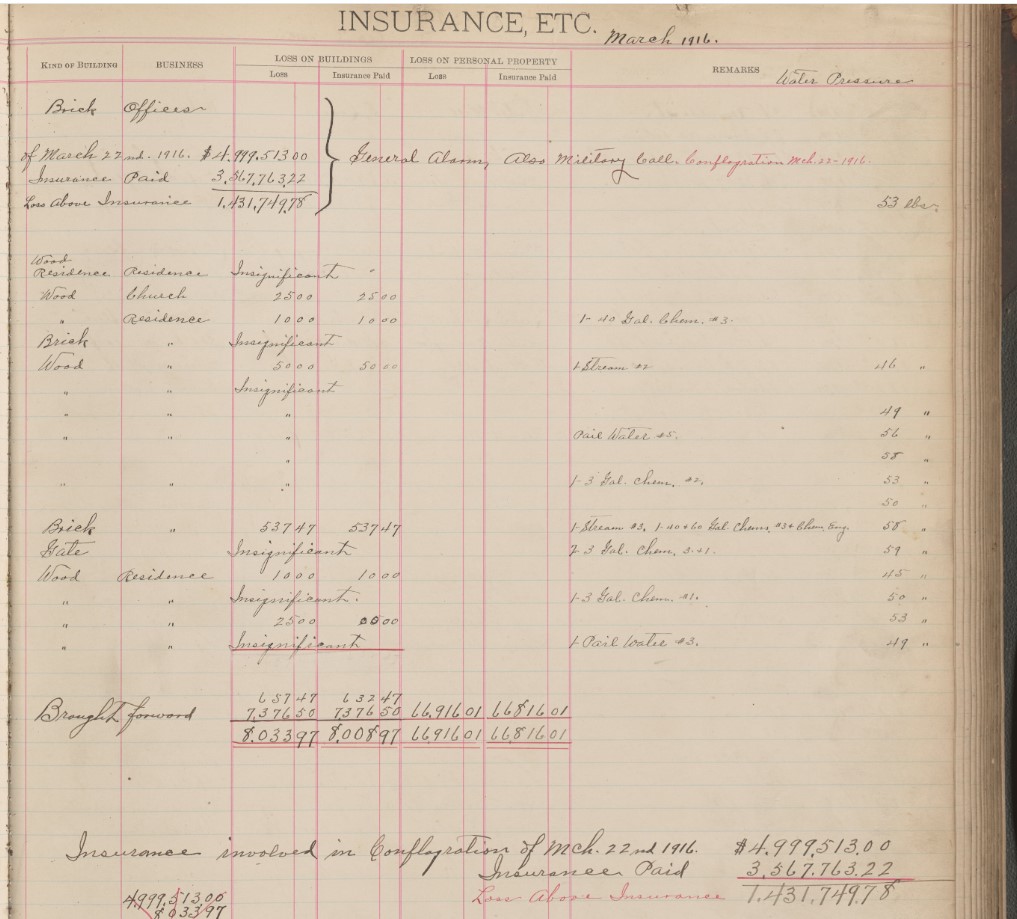
Five years later, on the night of November 26, 1921 the 700 block of Broad Street was again leveled by fire. This time destroying both the Albion and Genesta Hotels. Haunting images taken in the days that followed show only the arched marble and white brick shell of the Albion still standing among the heaps of smoldering rubble. The images call to mind the bombed-out desolation of European cities during World War II. As with the Great Fire of 1916, the AFD ledgers record call box 34 again sounding the first alarm at 1:50 am, along with the financial cost incurred.
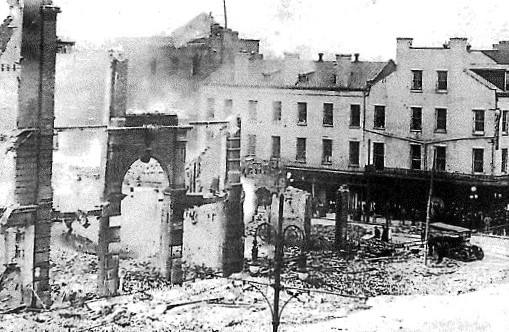
Several other Augusta grand hotels succumbed to fires during this period. In the middle of the night, on February 3, 1921 call box 411 signaled a fire at the corner of Walton Way and Hickman Road. The illustrious Bon Air Hotel was burning. Standing at the entrance of Augusta’s exclusive Summerville district, the Bon Air was a playground for northern industrialists, politicians, and affluent families who wintered in Augusta due to its mild climate. According to the AFD ledger the hotel was a total loss, building and contents destroyed. Situated on the Sand Hills, a few miles west of Augusta, Summerville was established as a small village in the late 1700s and by the mid to late nineteenth century began attracting the northern elite. Referred to as “The Hill” by locals, Summerville offered relief from the heat, humidity, and mosquito-borne diseases that plagued Augusta due to its placement along the Savannah River and swampy lowlands.
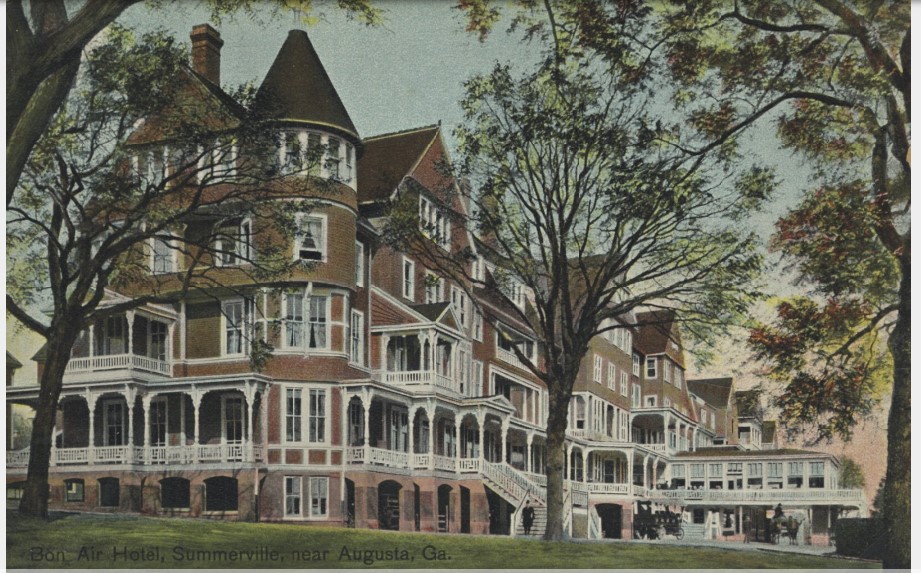


While the AFD ledgers record the major fires that destroyed significant portions of Augusta during the early part of the twentieth century, they also document smaller, less destructive fires that might not have ever been reported in newspapers or other sources, along with identifying information about the individuals associated with the property. In May of 1906, a typical day in relation to the number and severity of the calls coming in, 27 were recorded, 26 from the call boxes and one by telephone. About half the fires were noted as insignificant, including a call that came in on May 23rd at 10:45 PM from call box 19 indicating a fire at 426 Greene Street. The ledger notes that the address is a residence owned and occupied by A. J. Tweedy. The cause of fire is listed as “window curtains.” Likely started by a candle flame or gas lamp coming in contact with the curtain, this fire is described as insignificant.
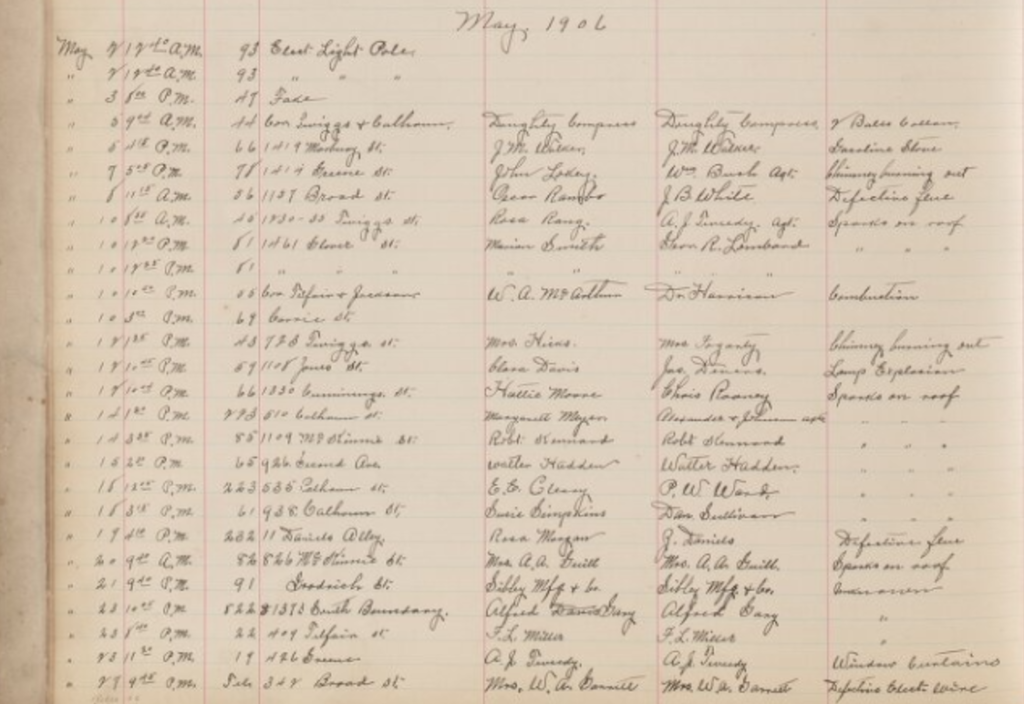
Used in conjunction with additional Augusta resources, the AFD ledgers paint a more complete picture of the city’s historical landscape particularly of its people and places. They are also a beneficial to genealogists searching for ancestors and places those ancestors may have lived. For example, searching the 1905 Augusta City Directory to learn more about A. J. Tweedy, researchers will see that Albert J. Tweedy and his wife Emma were living at the Greene Street residence and Albert was the manager of the Tweedy Loan Company at 738 Ellis Street. When viewed as a single primary source the Augusta Fire Department ledgers simply record names and addresses, but in complement with other primary sources such as city directories, Sanborn maps, and historic newspapers, people and places come alive, individuals are personalized and no longer just a static entry recorded in a historic ledger.
It is also interesting to note that the Sanborn maps for Augusta reveal a lot about how the city worked to prevent large scale fires following the Great Fire of 1916. Taken from the 1917 Sanborn Map of Augusta, one year after the destruction. The image below shows the 700 block of Broad Street and the buildings which were destroyed along with those being rebuilt using “fire proof construction.” According the Augusta City Council Yearbook for 1916, “Almost immediately after the fire, a new building code was adopted which called for a better class of construction throughout.” This is evident in the image below that shows steel frames replacing the outdated and dangerous practice of wood framing.

The threat of catastrophic fires plagued U. S. cities until strict building codes, technological changes, and loosely organized volunteer fire departments were consolidated under the administration of city governments. All of this occurred during the late nineteenth, early twentieth centuries. The Augusta Fire Department ledgers are a window into this time period of major changes, and a wonderful resource for exploring fire history not only in the city of Augusta, Georgia but throughout the United States.
Augusta-Richmond County Public Library System is grateful to Chief Keith Lively of the Augusta Fire Department for donating this one-of-a-kind record set, and to the Digital Library of Georgia for making it available to the public through their website www.dlg.org.
Visit the Georgia Heritage Room through the month of February to see the Augusta Fire Department ledgers on display. Call 706-826-1511 with questions.

